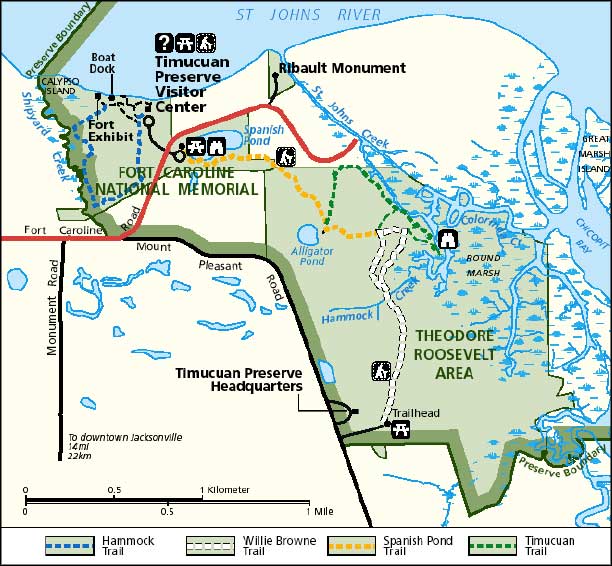Timucuan Ecological and Historic Preserve

Timucuan Ecological and Historic Preserve is a 46,000-acre park located in Jacksonville. The Preserve is managed through a cooperative agreement between the National Park Service, the City of Jacksonville Department of Parks and Recreation and the Florida Department of Environmental Protection. More than 300 private properties are contained within the Preserve, and two of the public properties contained in the Preserve are Fort Caroline National Memorial and Kingsley Plantation. The park was established in 1988 specifically to protect critical wetland habitats from development and destruction.
The Theodore Roosevelt Area is a 600-acre property bequeathed to the public by Willie Browne, the property's last private owner. This is an area where you can explore miles of wooded nature trails and discover a vast grassland filled with both land and water mammals. There are also several shell mounds and middens, left behind by a long-vanished Native American culture.
The Ribault Club was built on Fort George Island in 1928, and is preserved now as a monument to the resort era from those days. As a wintertime recreational resort, the Ribault Club offered members tennis, golfing, fishing, hunting and yachting. During its heydays, the club was known as a "large house party." Dropping membership during the Great Depression forced the club to sell its property. Subsequent attempts to resuscitate the property as a centerpiece for a residential resort community failed and the club became part of the Fort George Island Cultural State Park in 1989. The Ribault Club was placed on the National Register of Historic Places and since then, a partnership between the National Park Service, Florida State Parks and the City of Jacksonville have funded a full renovation of the Club. Interactive exhibits at the club cover the full natural and cultural history of Fort George Island.
Cedar Point, on the southern tip of Black Hammock Island, was a cotton plantation area back in the 1800's and a pine plantation in the 20th century. Since the days of big timber ended, the 400-acre property has been allowed to return to its natural state and visitors get to experience the reinvigorated salt marsh habitats and the upland hardwood hammocks. You'll find some of the best fishing spots in the Jacksonville area here, and some of the best spots for watching birds.

The Rimbault Monument
The Ribault Monument was erected in 1924 on a piece of land near the community of Mayport. The monument commemorates the landing of Jean Ribault, a French Protestant (Huguenot) who landed near here and claimed the land for France. The monument was also an attempt to remind modern Americans that some of the first efforts to colonize America were in the name of religious freedom, more than 50 years before the Pilgrims arrived at Plymouth Rock. For various reasons, the monument had to be moved three times until it found a permanent home on St. Johns Bluff and became part of the Fort Caroline National Memorial.
The preserve visitor center is located at the Fort Caroline Memorial. There is also a visitor contact station at the Kingsley Plantation. The facilities and grounds at the visitor center and station are open daily from 9 am to 5 pm. The preserve headquarters is open from 7:45 am to 5 pm Monday through Friday except for all government holidays. The Theodore Roosevelt Area is open from sunrise to sunset, however, the restrooms are only open from 9 am to 4:30 pm. Cedar Point is open from sunrise to sunset but there are no facilities. Spanish Pond and the Ribault Monument are open from 9 am to 4:45 pm daily. The inter-agency visitor center at the Ribault Club is open Wednesday through Sunday only, from 9 am to 6 pm. All National Park Service areas of the Preserve are closed for Thanksgiving, Christmas and New Year's Day.
There are no admission fees to the National Park Service areas of Timucuan Preserve. Groups planning to visit Kingsley Plantation, Fort Caroline or the Ribault Club need to make reservations in advance.
Adjacent to and overlapping in some areas is the Talbot Islands State Parks group: Amelia Island State Park, Big Talbot Island State Park, Little Talbot Island State Park, Fort George Island Cultural State Park, Pumpkin Hill Creek Preserve State Park, Yellow Bluff Fort Historic State Park and George Crady Bridge Fishing Pier State Park.
